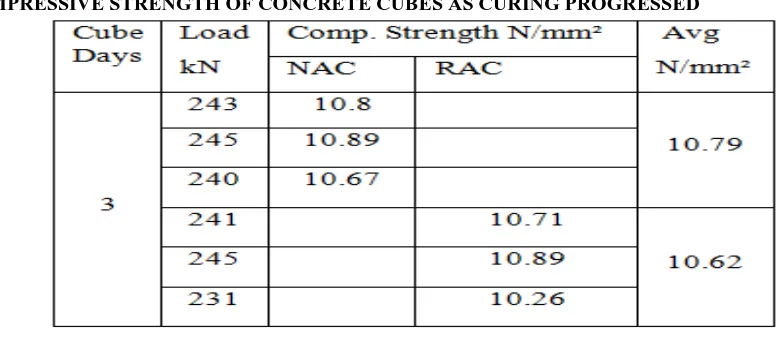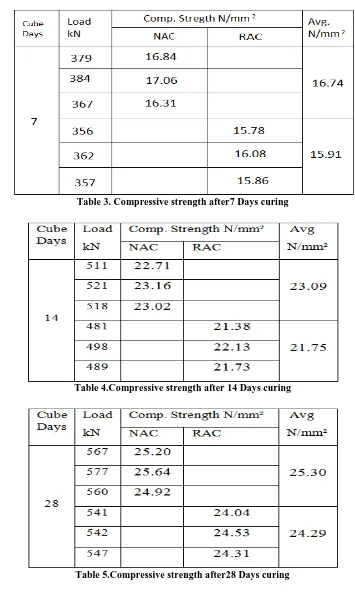ISSN (e): 2250-3021, ISSN (p): 2278-8719
Vol. 08, Issue 6 (June. 2018), ||V (III) || PP 66-70
Comparative Study of Natural and Recycled Aggregate Concrete
Chaitradip Sarkar
1, Parikshit Chauhan
2,
NavedKhan
³
,Abu Sufiyan
Khan
4,Mohammad Aquib
51(Research Scholar, Department of civil Engineering, G.H. RAISONI POLYTECHNIC ,NAGPUR) 2
(Research Scholar, Department of civil Engineering , G.H. RAISONI POLYTECHNIC ,NAGPUR)
3
(Research Scholar, Department of civil Engineering , G.H. RAISONI POLYTECHNIC ,NAGPUR)
4(Research Scholar, Department of civil Engineering , G.H. RAISONI POLYTECHNIC ,NAGPUR) 5(Research Scholar, Department of civil Engineering , G.H. RAISONI POLYTECHNIC ,NAGPUR)
Corresponding Author: Mohammad Aquib
Abstract:
Indiais presently generating construction and demolition (C & D) waste around 23.75 million tons annually and these figures are likely to double fold in the next 7 years. C & D waste and specifically concrete has been seen as a resource in developed countries. Works on recycling have emphasized that if old concrete has to be used in second generation concrete, the product should adhere to the required compressive strength. The project done on recycled aggregate from demolished concrete. Our aim is to investigate the characteristics of recycled aggregate concrete, with respect to various parameters. After analysis of results of various tests done on recycled aggregate and natural aggregate it found that the recycled aggregate shows different result values, which implies that RA and NA are very different regarding various properties. But the Control mix showed better results with recycled aggregate. Results shows that compressive strength of recycled aggregate concrete depends upon grade of concrete which demolished to obtain recycled aggregate and the age of demolished concrete.Keywords:
Recycled aggregate concrete (RAC), Natural aggregate concrete (NAC), Compressive
strength
--- --- Date of Submission: 01-06-2018 Date of acceptance: 16-06-2018 --- ---
I.
INTRODUCTION
Demolition of old and deteriorated buildings and traffic infrastructure, and their substitution with new ones, is a frequent phenomenon today in a large part of the world. Rapid infrastructure development requires a large quantity of construction materials, land requirements & the site. This results in production of more waste. Out of the total construction demolition waste, 40% is of concrete, 30% ceramic’s, 5% plastics, 10% wood, 5%metal, & 10% other mixtures. Worldwide,infrastructure spending will grow from $4 trillion per year in 2012 to more than $9 trillion per year by 2025. Overall, close to $78 trillion is expected to spend globally between 2014 and 2025. These figures indicate a tremendous growth in the construction sector, almost 1.5 times in 5 Years. For production of concrete, 70-75% aggregates are required. Out of this 60-67% is of coarse aggregate & 33-40% is of fine aggregate. The main objective was to explore the feasibility of incorporating recycled coarse aggregate in new concretes of similar or higher strength grades and mitigate the effect of the reduction in strength of Recycled aggregate concrete by designing a proper mix.
The main reasons for this situation are changes of purpose, structural deterioration, rearrangement of a city, expansion of trafficdirections and increasing traffic load, natural disasters (earthquake, fire and flood), etc .
The most common method of managing this material has been through its disposal in landfills. In this way, huge deposits of construction waste are created, consequently becoming a special problem of human environmental pollution. . Recycled aggregate is generally produced by two-stage crushing of demolished concrete, and screening and removal of contaminants such as reinforcement, paper, wood, plastics and gypsum. Concrete made with such recycled aggregate is called recycled aggregate concrete (RAC). The main purpose of this work is to determine the basic properties of Recycled aggregate depending on the coarse recycled aggregate content, and to compare them to the properties of concrete made with natural aggregate (NAC).
II.
MATERIAL AND METHODOLOGY
shaped natural sand having finenessmodulus 3.2 and specific gravity 2.8 used as fine aggregate in concrete. The aggregates from crushing of natural stones in crushing plant of maximum aggregate size 20 mm used for casting concrete cubes. The demolished sections of concrete crushed mechanically and sieved to separate the various size of aggregate, here also the maximum aggregate size was 20 mm. Potable water free from salts used for casting the concrete cubes and for immersed curing as per IS: 456-2000 recommendations.
III MIX DESIGN BY INDIAN STANDARD METHOD (IS 10262-1982)
Concrete mix-design is a step by step design procedure to determine the percentage of various ingredients of concrete to achieve maximum strength. Mix designed with the consideration natural aggregate and the concrete with recycled aggregate casted with the same design to check the feasibility of recycled aggregate with respect to natural aggregate .To design, the compressive strength of concrete after 28 days of curing considered , the water content and proportion of fine aggregate corresponding to maximum size of aggregate are first determined for reference value of workability water cement ratio and grading of fine aggregates are then adjusted for any difference in workability.
TESTS ON COARSE AGGREGATE
Sr .No Test Natural Recycled
1 Shape Angular Angular
2 Specific gravity- 2.96 2.49
3 Surface Texture Rough Rough
4 Water absorption 1.02% 6.84%
5 Dry lose bulk density (DLBD)
1.61kg/lit 1.49kg/lit
6 Impact Value 3.62% 12.98%
7 Abrasion value- 13.54% 38.24%
Table 1. Various Tests on Natural and Recycled Aggregate
IV COMPRESSIVE STRENGTH
The compressive strength of any material is definedas the resistance to failure under the action of compressive forces.Especially for concrete, compressive strength is an important parameter to determine the performance of the material during service conditions.The testing machine may be of any reliable type of sufficient capacity for the tests and capable of applying the load at the specified
rate.
The permissible error shall not be greater than 2 percent of the maximum load. The testing machine shall be equipped with two steel bearing platens with hardened faces. One of theplatens shall be fitted with a ball seating in the form the portion of a sphere. The centre of which coincides with time central point of the face of the platen.COMPRESSIVE STRENGTH OF CONCRETE CUBES AS CURING PROGRESSED
Table 3. Compressive strength after7 Days curing
Table 4.Compressive strength after 14 Days curing
Table 5.Compressive strength after28 Days curing
V RESULT
Table 6 Comparative graphic representation of compressive strength of Natural and Recycled Aggregate Concrete.
VI
.
CONCLUSION
Due to use of recycled aggregate in construction, energy, cost & natural resources saved to a very large extend. Use of recycled aggregate directly reduces the impact of waste material on environment. Quality controlled Recycled aggregate concrete can give a satisfactory performance. Compressive strength of concrete mainly depends on the quality of recycled aggregate and the quality of aggregate depends upon the grade of concrete crushed to obtain the recycled aggregate and age of the parent concrete along with recycling method as well as the knowledge of all the specificities related to mix design and preparation of these types of concrete. According to the test results, the performance of recycled aggregate concrete, even with the total replacement of coarse natural with coarse recycled aggregate, is satisfactory and shows that there is enormous scope of this aggregate in at present and in future, not only in terms of the mechanical properties, but also the other requirements related to mixture proportion design and production.
REFERENCE
[1]. Use of Recycled Aggregates in concrete , S.K. SINGH, Scientist, Structural Engineering Divis, Central Building Research Institute ,Roorki And P.C. Sharma,Head(Retd.),Material Sciences, SERC and editor New Building Materials and Construction World, New Delhi, Chairman, Indian Concrete Institute U.P. Gaziabad Centre
[2]. Properties of Concrete made with recycled aggregate from partially hyderated old concrete National building Research Institute,Dept. Of Civil Engineering,Israel Institute of technology,Haifa 32000,Israel . Amnon Katz,2003
[3]. Use of Recycled Aggregate Concrete Mr. Tushar R Sonawane1,Prof. Dr. Sunil S. Pimplikar research Graduate Maeer’s Mit Pune, H. O. D. Civil Engg.Department, Maeer’s Mit Pune. IOSR Journal of Mechanical and Civil Engineering (IOSR-JMCE) ISSN: 2278-1684, PP: 52-59,2005
[4]. Research on Recycled Concrete Aggregate C.T., Ong, K.C.G., Akbarnezhad, A. and Zhang, M.H. Department of Civil and Environmental Engineering, National University of Singapore, Singapore ,Electronic Journal of Structural Engineering 13(1) 2013
[5]. Transportation Applications of Recycled Concrete Aggregate—FHWA State of the Practice National Review 2004; U.S. Department of Transportation Federal Highway Administration: Washington, DC, USA, 2004; pp. 1-47.
[6]. Recycling of Demolished Concrete and Masonry; Hansen, T.C., Ed.; Taylor and Francis: Oxfordshire, UK, 1992; p. 316. Sustainability 2010, 2 1224
[8]. Y P Gupta ―USE Of Recycled Aggregate In Concrete Construction:A Need For Sustainable Environment‖ 34th Conference on OUR WORLD IN CONCRETE & STRUCTURES: 16 – 18 August 2009, Singapore
[9]. Properties of Recycled Aggregate Concrete Mirjana Malešev, et al., Properties of recycled aggregate concrete Contemporary Materials, V−2 (2014), Mirjana Malešev, Vlastimir Radonjanin, Gordana Broćeta,2014
[10]. F. A. Mirza and M. A. Saif, ―Mechanical properties of recycled aggregate concrete incorporating silica fume,‖ in Proceedings of the 2nd International Conference on Sustainable Construction Materials and Technologies, Coventry University and The University of Wisconsin Milwaukee Centre for By-products Utilization, Ancona, Italy, June 2010


